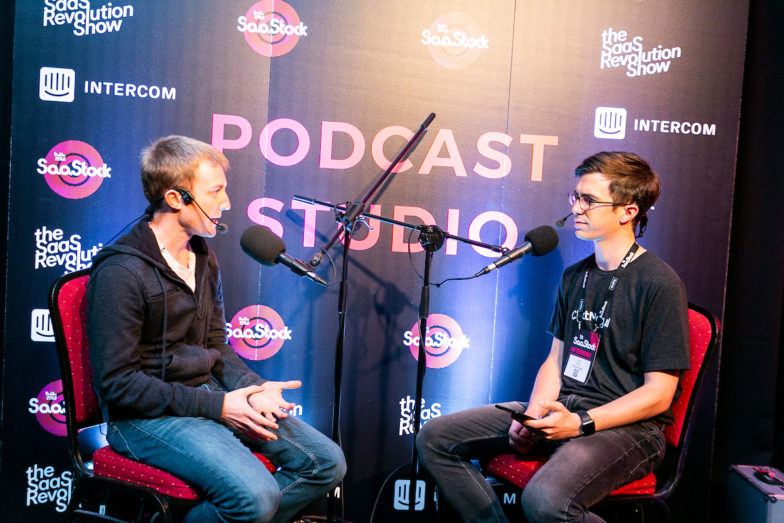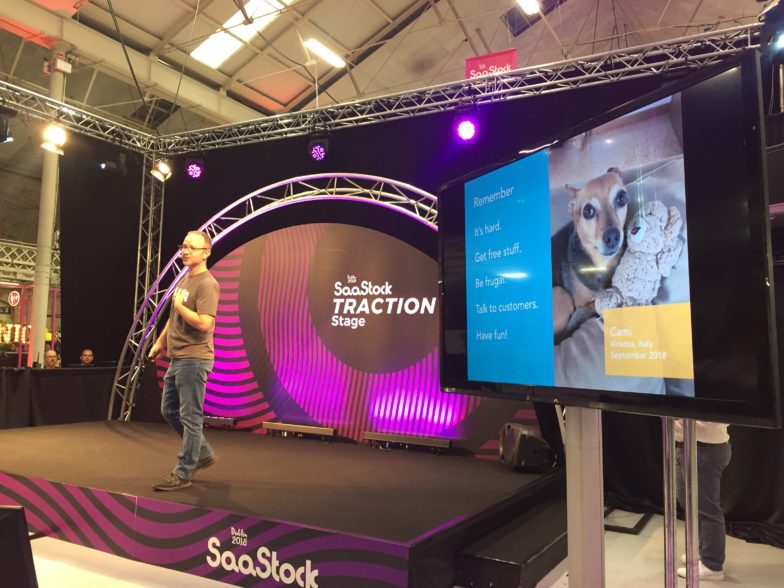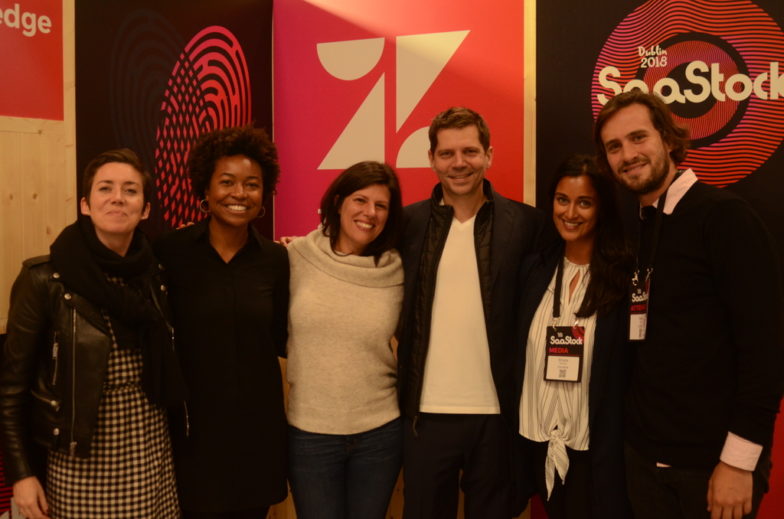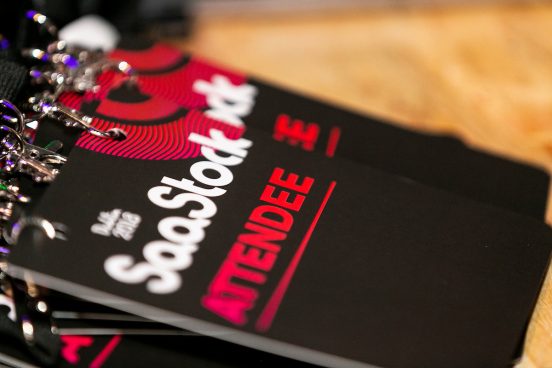SaaStock Day 1
Tuesday 16 October
You can’t be everywhere at once. That’s why we’ve created SaaStock Live, our on-the-go recaps of key sessions throughout SaaStock 2018. Our reporters, Annie and Despina, will keep you up to date and fill you in on exciting stuff you might have missed.
You can also follow along on Instagram and Twitter!
_____________________________________________________________________________
19:00 SaaStock is for Humans (and for Guinness)



“Humans tell the messy stories that numbers can’t”. Powerful quote by @AlisonMorris, Co-founder and VP, Customer Experience, of @sharehoney pic.twitter.com/o4BUMNkIu5
— SaaStock (@SaaStock) October 16, 2018
Brilliant talk from @davegerhardt – people can copy your functionality, they can’t copy your brand!
The best way to build a brand is through honesty…
“I love it when a waiter tells me what to order” 🙌🏻#SaaStock18 #marketing #branding pic.twitter.com/ZK9bbYwxoI
— Jeni Smith (@Jeni_Smith_) October 16, 2018
https://twitter.com/ThomasSmale/status/1052203317978378241

Congratulations to TravelPerk for raising $44 Million
16:45 – Why building a brand is the best investment you can make
David Gerhardt
VP of Marketing, Drift
Scale Stage
Dave Gerhardt graduated from college in 2009 during a global economic crisis, with no clue what he wanted to do. Fast-forward 7 years: Dave runs marketing at Drift, one of Boston’s fastest-growing startups, and is a figurehead in Boston tech.
How do you actually compete?
Drift is one of 7,000 other marketing automation products. In any industry, a business will have 10-100-200+ competitors. So how do you get noticed?
Drift tried tinkering with their website and content in hopes of appearing higher in search results.
“We knew Pay-Per-Click wouldn’t be magic. Same with SEO. There were other companies in marketing automation that had been around much longer and already secured those rankings.”
So, PPC and SEO are obviously not good options for customer acquisition anymore. What do you try next?
Think about how YOU buy for your business. You research, you ask friends, you check G2 Crowd.
By the time people get to your website, they already know what you do and something about you.
As buyers, we don’t get sold to anymore. We BUY. B2B buyers don’t want to deal with a sales person anymore.
In a world of infinite supply, your choice is to build a brand that stands out.
What’s a brand, really?
Mark Benioff, Salesforce CEO, writes that, “A brand is a company’s most important asset.” Stats, facts, and features can be duplicated and improved on by competitors. But no one can copy your brand.
Be real, authentic, human
Create a “damaging admission” and address your flaws openly. As marketers this seems anathema, but it’s an effective strategy. It enhances your credibility and endears you to the customer.
Some consumer examples of being real:
- Snapchat and Instagram: These two social media platforms totally took off. It’s live, raw broadcasting. Not overly produced, not edited.
Twitch: 335 billion hours of video gamers watching each other play video games. - Casey Neistat: YouTube star with 10M subscribers. He built the audience through vlogging about his daily life. Just mundane realness.
- Glossier: Have you ever heard of a skincare and beauty line that doesn’t use models in their marketing? Glossier always uses real people. Their homepage features people of different ages, races, and body types.
Drift as B2B example of being real:
- Killed stock photos, use real employees in content
- Plain text emails. Use videos with real employees there, too.
- Did a homemade iPhone video with 100 employees and put it on LinkedIn. Huge branding success!
“Non-fiction is easier than writing fiction.” – Yvon Chouinard, CEO of Patagonia
– Annie
16:30 – Europe is the best place to start and keep your business (in case you had any doubts about that)
Chat to the lovely people from the European Commission about it

15:50 – Product led sales: How to sell in a post-demo world
John Sherer, Director of Sales at Appcues
Growth Stage
John Sherer explained to us why product-led sales is the sales method every SaaS should adopt.
Product-led growth does not mean “get rid of your Sales team”
Salespeople should be always be there to guide the user/prospect through the product and speed up the sales process. Their role should be to add value to the user by guiding them via the product itself and triggering the user to move down the sales funnel at the same time.
To achieve product-led growth with a synched sales org, SaaS startups should follow 5 tactics:
- The marketing SLA should have qualification criteria. Otherwise sales people may not provide qualified leads. In other words, marketing should have goals in terms of PQL passed to sales!
To solve for this, Appcues uses MadKudu, and sales gets only the good leads. - Deal stages need to be prospect behavior not rep behavior.
Measure what actions somebody does in your product to lead to a purchase. This is an approach the product-led era thrives with! - Be firm when your trial expires but arm your reps with flexibility.
Give your reps the flexibility to trigger prospects with tactics that would enable the latter to return into the product on their own. An optional trial extension could be a tactic like that, which would allow a product qualified lead to further explore the product capabilities. - Use product triggers to drive reps to act in real time and then follow up contextually. E.g.- A rep sees a user activate a certain team. Your rep reaches out immediately. “Your development team was activated into our product. Let’s talk about your upcoming milestones and how our product will help you achieve them.”
- Sales reps should be armed with product knowledge to better support prospects and customers. Reps with product knowledge speed up the sales cycle. E.g.- At Appcues, product training is a must. Each sales rep goes through an extensive training within the first two weeks, in order to be able to deliver value to the customer ASAP.
– Despina
15:15 – How I Bootstrapped My Business from 0 to $50 ARR in just 4 Years
David Clay Smith, Founder and CEO of Akita
Traction Stage
Clay Smith is the founder of Akita, a Customer Success Management platform for SaaS businesses. Prior to founding Akita, Clay was Head of Technology at Dublin-based Franchise Direct. Clay has a keen interest in helping companies harness data to make their customers more successful.
The title of this talk is not a typo; it’s tongue in cheek.
“Some people will catch lightning in a bottle, but it’s a slog for the rest of us.”
Smith took the stage to share his honest story of a four-year struggle to find paying customers. Not your typical glossy-magazine-cover story, he showed us there are other paths to success. And offered six points of advice to struggling SaaS entrepreneurs who are bootstrapping the business they love.
1. Take advantage of any opportunity designed to help you succeed.
- Workshops
- Seminars
- Accelerators
Amazon and Google offer free hosting to cover first year or two, and other companies offer steep discounts on their products and tools.
2. Get a co-founder. Maybe two.
Smith was a solo founder for a while until he realized he’d need help. His partner joined, along with two others, and with four people on the team, he felt a huge relief.
Co-founders will:
- Speed up progress, help you move faster.
- Provide emotional support.
- Provide validation! If you cant convince someone to join you on the journey, you’ll have a hard time to convince customers.
3. Talk to your customers early and often
In February 2015, Smith and his partner moved to Mexico and decided to package product as a Chrome extension.
Once they talked to customers, they realized their product would be good for Customer Success teams. So Smith finally got clarity on the target customer and what direction to move the company.
Book recommendation: Running Lean, by Ash Maurya.
It’s 2.5 years in, and Akita is out of money.
“We have a product roadmap but are super broke. We looked at our roadmap and our bank account, and back again. This is the point where a lot of startups fail. They don’t talk to customers soon enough, didn’t experiment enough, didn’t iterate on feedback. Basically, ran out of money before they found traction.”
Smith says Akita was lucky, because they didn’t need to give up. Instead, they each got second jobs, contracting on the weekends.
Options before you give up:
- Get a side hustle
- Look into government aid programs.
- Accelerators. Try it now or do it again.
- Angels and VCs: it’s hard, not for everyone (only for high-growth businesses), can be risky.
“Had Akita raised money on day 1, we would have spent it early and probably been out of business by now.”

4. CUT COSTS. Go as low as you can.
Smith and his partner cut down on rent costs by pet sitting around the world! He went into detail about how to pet sit, which I thought was a pretty funny satire on the usual SaaS slides.
But on serious note, he suggested the following ways to truly trim the fat:
- Cancel unnecessary subscriptions
- Reduce hosting costs
- Eat in
- Get creative to extend your runway
In April 2016, things were slowly improving, but Akita’s product was expensive and the sales cycle was long.
Smith admits to making several mistakes, and he suggests asking yourself these questions to avoid the same mistakes:
- What’s your product strategy, and is it good?
- Do you feel like you’re just copying competitors?
- Are you chasing the golden feature that doesn’t exist? (“Sometimes we’d build XYZ because a potential customer asked for it.”)
- Is your business scalable?
- Are you being realistic?
If you make enough of these mistakes, don’t be afraid to start over.
“42 months after we started, we started over.”
In February, 2017, Akita started over from scratch. They called all leads in their pipeline and told them they’re no longer selling Akita.
“We had learned a ton and talked to a ton of customers. We were sure we learned what to build now. We did mockups, then demos, and got feedback right away. It was immediately positive! So we started building again.”
5. Make sure you’re having fun.
“It’s going to be hard. It’s going to take a long time. If it’s not fun, it’s not worth it.”
In November 2017, Akita acquired its first four customers and $500 MRR. Their inbound leads picked up and the sales cycle shrank. They got referrals from existing customers, whose own accounts started expanding.
Now, Smith and his partner are still pet sitting around the world and keeping costs low. But Akita is growing 10-15% MOM. And they’re excited about the future.
– Annie
15:00 – Afternoon happenings
We’ve just launched our Startup Report!
Our Startup Report has been published and is available for downloading here 👉 https://t.co/bJ5grPRcON #SaaStock18 pic.twitter.com/SWYSz4kciR
— SaaStock (@SaaStock) October 16, 2018
Keeping everybody up to date:
Spotted @profitwell Founder and CEO @Patticus discussing where #SaaS founders should focus their efforts to get the highest impact as they scale. Hearing innovative SaaS entrepreneurs at @SaaStock is always a great way to stay up to date on the most current trends in the market! pic.twitter.com/0GPNUeDjsR
— FE International (@FEIntl) October 16, 2018

https://www.instagram.com/p/Bo_js1EFIEr/?utm_source=ig_web_copy_link


13:00 – Building a financial plan to manage your business
Markus Grundmann, Senovo VC
Traction Stage
Markus delivered an efficient, value-packed talk on the Traction stage about the 5 elements of a successful financial plan. Sharing his insights from an investor’s point of view, he explained how best to model the different areas of your business.
Sales funnel
Customers
Revenues
Personel
Cashflow

Sales
- Hiring will be your first bottleneck: start with modeling the sales team.
- Give yourself time to ramp up the team. Efficiency increases over time; better to lay the right foundation.
- Model the complete sales funnel: conversion rate, stage duration
Customers
- Segment them! Markus says, as an investor, he’s surprised to find that 90% of startups don’t segment their customers. You can’t tackle churn and revenue retention without segmentation. He recommends at least an SML (Small-Medium-Large) approach.
- Track in cohorts: upsell & downsell, churn. Also segment these metrics!
Revenues
- Deferred
- Split by type
- Split by customer segment
Don’t forget to model revenue recognition, installments per month, when it comes to upfront annual payments!
KPIs to track
- CAC & CAC payback. These metrics answer, “How quickly do I earn back the money back that I spend on acquiring a customer?” Markus says CAC payback is the most important, even more than CLTV, because there are less assumptions. “It’s more pragmatic.”
- Total new MRR & churn. This is obvious in SaaS!
- New MRR per sales rep & quota attainment. These are about sales efficiency. See how the compensation scheme will play out over time, based on quota attainment rates. As for MRR per rep, a good number to aim for is 3-4x revenue than the cost of the rep.
- Gross margin per customer.
Team
- Model 2-3 levels per sub team, such as marketing, sales, and development. Don’t lump it all together because as you hire, you wont be able to track if you’re in line with budget.
- Make realistic assumptions on salary, variable pay, etc.
Cashflow
- Consider payment terms. If you have 3-year, 2-year, or 1-year contracts, model them differently!
- Optimize for upfront payments. “This is the silver bullet.” Essentially, upfront payments are free financing.
Senovo is a German early stage VC fund focused on B2B SaaS investments. They’ve shared their financial plans in an open-source format! Check out their free resources here:
tiny.cc/enovo_finplan_medium
tiny.cc/senovofinplan
– Annie
12:15 – How to run a growth-minded team
Kieran Flanagan, VP Marketing/Growth at HubSpot
Growth Stage
Every company hits growth ceilings. Scaling is about breaking through them. And it often comes down to the people on your team.
The people you hire matters a lot
As an individual marketer, Kieran thought his success depended upon himself, but now he realizes it depends on the people he hires and retains.
- As a growth-minded leader, think of attracting candidates the way you attract users to your product. Show employees they can have impact; that’s their “aha!” moment that convinces them to join the team.
- Diverse teams are best. Different backgrounds bring different perspectives on how to solve problems
- Find people with marketing channel expertise, who are curious about new growth levers.
But before you begin, be clear of what you’re looking for. At HubSpot, Kieran has scorecards for three areas of a candidate’s fit.
- Team values: what fits with your culture
- Core skills: attributes of the candidate
- Technical skills: to Kieran, these matter the least because they are coachable.
How to hire growth-minded people
Tip #3: Use LinkedIn Recruiter. You can search by course completion, like tradecraft. See which people are actively pursuing their own professional development in the relevant area.
Tip #2: LinkedIn BuzzSumo. Idenfity people who create content or follow thought leaders.
Tip #1: Create a remote work culture. Provide work flexibility. Kieran says this helped, more than anything, to hire and retain the right people.
Set up your employees for success: shared goals
If you put ambitious people in an environment where they’re not in charge of their success — it will breed frustration. Many employees may complain that their performance is “dependent on other teams who don’t share the same metrics” and therefore measured unfairly.
True breakthrough growth only comes with inter-team collaboration. Create shared Key Results that every team can participate in and work toward.
“Think in terms of outcomes, not just outputs.”
Multiply what works
To increase one marketing channel, HubSpot dedicates someone from each functional team to explore it from every angle. For instance, to increase Search, they assembled a “full stack search team.” A full stack marketing team consists of an SEO specialist, content creator, data analyst, developer, and designer.
A scale-up company should consider this option. It’s not exactly viable for a startup whose resources are limited!
How do you prioritize?!
Prioritization in a scale-up is HARD. Everything needs to scale, needs to transform for growth. Everything needs your attention. So how do you know what to focus on first?
Kieran suggests plotting every initiative on a graph of Effort by Return, which categorizes things into four quadrants.
Low effort, low impact = Incubator. These are new ideas that you can explore on a small scale, giving them just enough resources to discover if it’s worth scaling.
Low effort, high impact = The Gold. Finding Gold opportunities only really happens in startup stage. You’ve likely found all of these by the time you scale. High effort, low impact = The Black Hole. Here you’re just losing money. Run away fast.
High effort, high impact = Scalable Growth. This is where you want to spend most of your time!
Kieran’s approach is to find new ideas, start them in the Incubator phase, and drag them into Scalable Growth.
How do you divide time between what channels will grow and what won’t grow? How do you know?
- Estimate your channel saturation. Try “burst tests,” which consist of saturating marketing channels with money and observing where the tipping point is.
- Create features on our website that fill highly searched content. E.g.- Transferwise, a money exchange and transfer service, added relevant features and resources to their website, such as a currency exchange directory. Users searching for this information immediately found Transferwise’s website, which increased organic traffic.
#GrowBetterPlatform
Check out Kieran’s GrowthTLDR podcast, too!
– Annie
12:00 – We are live on all stages!
#Scale stage at #SaaStock18 is on 🔥🔥🔥 as @BrynneSpeak, @Dthakker02, @fvdmaele & @fdouetteau are discussing how EU companies can expand to US 🤯 pic.twitter.com/0fImsPH94m
— SaaStock (@SaaStock) October 16, 2018
https://www.instagram.com/p/Bo_Rea1F_ub/?utm_source=ig_web_button_share_sheet
Founders, investors and executives sharing knowledge at #SaaStock18 No better place to learn about building a successful SaaS business 🎓 Already know that we’ll get back home inspired and pay it forward. pic.twitter.com/GbIAsxksX5
— Kogito Ventures (@KogitoVC) October 16, 2018
Incredible talk about onboarding from @jamesjgill. (Thanks for the shoutout!) If anyone else needs those graphs, word on the street is @hijonathan will send them if you ping him. 🙌 ✅ @GoSquared @SaaStock #SaaStock18 pic.twitter.com/MoZCJMT1U0
— Appcues (@Appcues) October 16, 2018
11:45 – F*** customer feedback!
Hannah Chaplin, CEO of Receptive
Scale Stage
Hannah Chaplin is the CEO at Receptive, a SaaS company helping other B2B SaaS businesses build winning products by collecting & acting on product feedback.
Question on the mind of many SaaS leaders: How to use free customer feedback to make your business scale?
Customer-facing teams have a spreadsheet of requests. Companies keep investing in creating the most optimized way to get the feedback they need.
On a daily basis, SaaS organizations receive all kinds of feedback. But if you want to narrow it down, you could focus on three different categories:
- Customer feedback: which includes daily hiccups and pain points
- Team feedback: that has to do with how your internal strategy is doing and how it can be optimized via your team’s ideas
- Market feedback: which concerns any kind of feedback you can get via any source whatsoever (from your website to social media channels, to communities, to even WOM going around on your product)
Now the first kind of feedback, the one you get from your customers, tends to be the most challenging. And it’s the one you should embrace no matter what!
How do you embrace customer feedback?
Step 1: Create a product feedback policy.
Collect the feedback, get it centralized, and communicate it back. Then set expectations about what you do with it.
Step 2: Feedback library
Stop spreading the feedback all over get it all in one place. Don’t just create a massive backlog of feedback requests that eventually is impossible to evaluate. Filter the feedback that’s actually valuable to you and find ways to deal with it effectively.
Step 3: Communicate back to users
Don’t just get feedback and keep it to yourself. It’s an opportunity to talk to users, to understand them, and to offer them a better experience. Show and share your progress to help you build a better relationship.
– Despina
10:30 – How to run a cash efficient business and target $20M ARR
Nathan Latka, CEO of SaaS Database
Adrien Menard, CEO of Botify
Growth Stage
Botify has run a cash-efficient SaaS business since 2011.
They were profitable before they raised money, which ended up being a $7M Series A in January 2016.
Since then, the company has grown at 2x, looking to close out 2018 with $15M ARR.
So, how did they do it? And what can they teach us?
Nathan Latka grilled Adrien Menard about the origin, growth story, and management tactics of Botify.
First, a little bit about what Botify actually does.
The problem: Google ignores 50% of the average website. If Google doesn’t know the pages, then the pages won’t be indexed or ranked and won’t provide organic traffic or revenue. Customers won’t find your business. So, as a SaaS company, every product page on your website needs to be in the Google index.
Botify’s solution: Botify’s service will audit your website and let you know where you stand and give you data about how to drive more traffic.
The birth of Botify
In 2012, Adrien and a couple colleagues found themselves in the emergence of cloud software, SaaS, and big data. So they turned their agency into a SaaS business, accomplishing the time and revenue-intensive transformation from a service approach to a software approach. They had one advantage on their side, though: paying customers from day one.
They started from scratch with the product, but these original customers helped shape it.
Six years later, Botify has 450 customers in 20 countries. What helped with this growth? A bit of funding and breaking into the American market.
In January 2016, they raised $7 million. This helped them jump into the US market, which Adrien says “changed the company dramatically because the market is so large, the customers are so large.” In fact, Adrien moved to the US to open an office there in September 2016.
What about cash efficiency?
Botify didn’t raise money until four years into their journey. Of course, paying customers from day 0 helps feed the machine. They grew carefully. And they were profitable before they raised the Series A.
“It was important to prove the capability to run the product in a sustainable, scalable way — and to know we can sell outside of France.”
Based in Paris, the first foreign market they entered was UK. Once confident of product scalability, they went for a series A.
To ensure cash efficiency, Adrien recommends a growth ratio of 1:1. That is, every $1 million raised to $1 million ARR.
Botify is now growing at twice that.
“We try to do everything 10x larger or 10x faster or 10x cheaper than the competition.”
They spend each dollar wisely, especially when it comes to developing a new piece of software. If it’s not efficient, then it’s hugely expensive!
How do you maintain negative churn?
- Monitor everything your customer is doing. Is there a feature they aren’t using? Manage their use and you will up their retention.
- Broaden the value proposition to upsell the customers. Botify focused on this in last 2 years. Some Botify customers will end up spending 7x the next year because they widened their scope and added features.
Any advice on how to run a cash-efficient SaaS sales organization?
- Aim for short sales cycles. 50% of Botify customers are sold in less than 3 months.
- Their inside sales team is 11 account execs and 11 SDRs, who carry quotas in pipeline but not in closed deals.
- Ruthlessly qualify your leads. This will also alleviate tension between your sales team and customer success.
Finally, he recommends paying to every detail, to make sure each part of your product, your team, your operations, is as strong as the other.
“To grow in a healthy way, you shouldn’t damage your unit economics.”
– Annie
9:15 – We have kicked off the show and have officially launched #TakingStockPledge

Drop by the Zendesk booth to sign the pledge and talk to the lovely people behind it

7:30 – Happy early risers

The small but super happy crew that woke up to go for a run before we opened doors. Photo by Emily O’Callaghan






